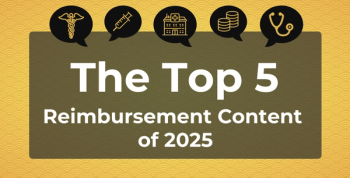
The American Journal of Managed Care
- November 2014
- Volume 20
- Issue 11
Variation in Hospital Inpatient Prices Across Small Geographic Areas
Greater geographic variation was found among private than public payers in the inpatient price per discharge for most hospital services.
Objectives
To examine whether market competition may influence the difference in the inpatient price per discharge between public (Medicare) and private payers across small geographic areas.
Study Design
Retrospective multivariate analysis.
Methods
Data came from the 2006 Healthcare Cost and Utilization Project (HCUP) State Inpatient Databases (SIDs) in 162 counties from 6 states where an HCUP price-to-charge ratio (PCR) was available. The SIDs were linked with the Area Resource File, American Hospital Association Annual Survey Database, and US Census Bureau data files. Hospital inpatient prices were estimated by applying the HCUP PCR to total hospital charges. Payer-specific price comparisons were made for all discharges, an acute condition (acute myocardial infarction), and an elective condition (knee arthroplasty). Ordinary least squares models were used to examine the effect of market competition on the inpatient price per discharge by payer.
Results
Greater geographic variation was found in the inpatient price per discharge among private than public payers for most hospital services. Hospitals in more concentrated markets were associated with a higher price per discharge among knee arthroplasty discharges for both payers.
Conclusions
Hospitals charged significantly higher prices to private than public payers. Because the payment policies from Medicare ultimately affect private payers, public policy efforts that take into consideration market-based approaches or payment reform may help to reduce price variations.
Am J Manag Care. 2014;20(11):907-916
- Greater geographic variation was found among private than public payers in the inpatient price per discharge for most hospital services.
- Hospitals charged significantly higher prices of private than public payers.
- Hospitals in more concentrated markets were associated with a higher price per discharge among knee arthroplasty discharges for both payers.
prices
1
3,4
5
The wide geographic variation in hospital , defined as the payment a hospital receives for delivering patient care for similar types of services, has been described previously. For example, a recent study indicated that inpatient prices for private insurance ranged from 147% to 210% of Medicare rates.Hospital inpatient prices have also been found to vary considerably across discharge types, states, and geographic localities without any meaningful differences in quality.2 These large variations have captured the attention of payers and policy makers looking for ways to curb excess spending from the healthcare system and promote greater transparency.Antitrust regulators have been concerned with the rising cost of hospital care and its impact on consumers.
6
7
Several factors have been cited as possible reasons for the wide price variations. The consolidated hospital market has been leading to increased prices. A study of 6 California metropolitan areas showed that providers with strong leverage are able to use their increased market power to negotiate substantially higher payments.A study by Medicare Payment Advisory Commission (MedPAC) found that hospitals with strong negotiating power were able to let their cost structure rise because they receive higher reimbursement rates from private insurance; these payments offset negative Medicare margins.The substantial price variation across geographic areas might exist because certain providers have significant market clout to negotiate higher-than-competitive prices.
between
price takers
5
5
price makers
Differences in how hospitals set their prices payers may also impact price variations. Because prices for Medicare are set administratively, hospitals do not develop any pricing strategies and are .Conversely, hospitals negotiate prices with private payers for specific procedures and conditions. There is a minimum price threshold—below which a hospital will refuse to contract with a private insurer—and a maximum price threshold—above which a private insurer will not contract with a hospital.The agreed-upon price will depend, in part, on market factors such as the level of competition intensity and “must have” status in the provider network. Thus, hospitals are with private payers.
dynamic cost shifting
1,5
8,9
The role of has also been cited as a contributor to price variation between payers. Some have suggested that below-cost payments from public payers lead to price increases for private insurers.An implicit assumption of this perspective is that hospitals have unused bargaining power with private insurers. When payments from public payers decline, hospitals raise their prices to private payers to offset declining margins by leveraging their market power. More recent evidence suggests that the market structure—whether a hospital is located in a concentrated or competitive market—will determine if hospitals raise their prices to private payers, cut costs, or perform both in response to payment shortfalls from public payers.
between
The changes in Medicare reimbursement expected under the Affordable Care Act (ACA) have led to some uncertainty regarding the implications of payment reductions by Medicare, the potential impact on private payers, and the confounding effect of market factors on hospital prices. Despite existing literature that has highlighted wide inpatient price variations, there is sparse evidence regarding the specific role that market competition might have in driving price variation payers. Previous studies examined only select conditions that were restricted to a few hospitals or market areas and did not use adequate measures to adjust for differences in patient health status.
The purposes of the present study are: 1) to examine differences in inpatient price per discharge between public (Medicare) and private payers among various hospital services across small geographic areas, and 2) to investigate the relationship between hospital market competition and payer-specific prices for several common discharge types. We hypothesized that there would be greater variation in prices paid by private payers compared with Medicare because of differences in negotiated prices and discounting by private payers. We also hypothesized that market competition might drive between-payer price variations.
METHODS
Data
We used data from the 2006 Agency for Healthcare Research and Quality Healthcare Cost and Utilization Project (HCUP) State Inpatient Databases (SIDs) and 2006
10
US Census Bureau population estimates. The data came from 6 states (California, Florida, Massachusetts, New Jersey, Wisconsin, and 1 state that the HCUP Data Partner chose not to reveal) where an HCUP price-to-charge ratio (PCR) was available. These states included hospitals that were most consistent in terms of how they reported their financial data (according to a conversation with Katie Levit, BA, with Truven Health Analytics, July 6, 2012). The HCUP SIDs contain all-payer information for inpatient stays and currently account for 97% of dischargesinUScommunityhospitals.
private insurance
Medicare
We used all nonmaternal discharges for patients 40 years and older. Patients aged 40 to 64 years with private insurance as the primary expected payer were classified as . Patients 65 years and older with a primary expected payer of Medicare were classified as .
11
12
We made payer-specific price comparisons for all discharges, an acute condition (acute myocardial infarction [AMI]), and an elective condition (knee arthroplasty). We selected these conditions because they represent common and costly medical or surgical conditions that occur in the adult population.We identified these conditions using principal diagnosis or principal procedure from the HCUP Clinical Classification Software.
We examined the effect of market competition on the price per discharge by primary payer across discharge types. We removed discharges with missing total charges, age, or primary expected payer. Hospitals with negative PCRs were also removed. We excluded counties where 50% or more of discharges were missing price information. We excluded hospitals with fewer than 11 discharges or small counties that did not have complete population characteristics. The final sample included 3,333,065 discharges across all discharges from 6 states.
Unit of Analysis
county level
13-15
16
We aggregated discharges from the HCUP SID to the based on hospital zip code as our geographic unit of analysis. We examined a total of 162 counties in 6 states across all discharges. Previous studies analyzed variation in healthcare spending and utilization at the county level.A previous study also found that different measures of healthcare markets are highly correlated.
Price Measures
net revenue
17
5
We estimated payer-specific inpatient prices () by applying the HCUP PCR to total hospital charges. The PCR calculates Medicare and private insurance inpatient net revenues—the payment a hospital receives— from gross inpatient revenue. The PCR is adjusted for contractual adjustments, discounts, bad debt, charity care, and other sources of inpatient revenue (eg, Medi- care disproportionate share hospitals [DSH], grants, and subsidies).The net revenue that a hospital receives is a more valid indicator of actual prices than billed charges, which are inflated.
price per discharge
The payer-specific inpatient was calculated by taking the sum of all hospital net inpatient revenues divided by total number of discharges at the county level. We calculated payer-specific rates by using number of patients in private insurance and Medicare payment groups. The Area Wage Index was used to adjust for differences in cost of living.
Market Competition
market competition intensity
18
19
The Herfindahl-Hirschman Index (HHI), which represents , was derived from the HCUP Hospital Market Structure File.HHI represents sum of square of market shares for all hospitals within a county. A hospital’s market share is calculated as total number of discharges at a hospital divided by total number of discharges in the market. The HHI ranged from 0 to 100, where 0 represents a market with many competitors, each having no influence on price, and 100 represents a monopoly. HHI is a standard measure of market competition and has been previously validated.We used a continuous measure of HHI and included a dummy variable for markets with monopolies. As a check for a possible nonlinear relationship between market competition and prices, we substituted the continuous measure of HHI with a categorical variable based on quartiles of the HHI distribution.
Empirical Analyses
5,8,20
5,8,17
We adjusted for patient, population, and market-level characteristics in our models. We derived from the SID patient characteristics that included age, sex, comorbidities, and an all-patient refined diagnosis-related group (APR-DRG) disease severity measure. Patient characteristics were included to adjust for disease severity.From the US Census Bureau, we obtained population characteristics that included the Gini index, unemployment rate, and proportion of the population with a bachelor’s degree. We derived market characteristics from the American Hospital Association Annual Survey and Area Resource File that included proportion of teaching and specialty hospitals, number of primary care physicians per capita, and number of acute care beds per capita. The selected population and market characteristics were included to adjust for factors that have been previously described as influencing hospital price setting.
We first examined the means and distributions of our sample and calculated the correlation in price per discharge among payers using Pearson’s correlation. Medicare and private insurance results were examined as scatter plots. Our empirical approach used an ordinary least squares regression (OLS) model with robust standard error—analyzed separately by payer—to estimate the relationship between market competition and inpatient price per discharge. In the multivariate analysis, we used the log of price per discharge to focus on percentage of payment as opposed to the specific dollar amount. We adjusted our models to account for areas with a small number of discharges by including the standard error of price per discharge in the regressions and weighted the county by the number of discharges by payer. State dummy variables were included to account for differences between states.
21
As a sensitivity analysis, we re-estimated our linear models using a robust regression with Huber weighting to assess the validity of our results. The robust regression uses iteratively reweighted least squares and assigns a weight to each observation with higher weights given to better behaved observations.We report results from both the OLS and robust regression models.
RESULTS
Descriptive Analyses
Table 1
P
P
P
The average prices per discharge by payer are represented in 2012 dollars (). Results revealed that the average price per discharge for private insurance was nearly twice as high as for Medicare across each of the different types: all discharges ($7628 Medicare vs $13,713 private insurance; <.0001), AMI discharges ($11,000 Medicare vs $23,485 private insurance; <.0001), and knee arthroplasty discharges ($10,824 Medicare vs $21,098 private insurance, <.0001). Among all discharges for Medicare, the price per discharge in the county with the highest rate was more than 4 times higher than the price in the county with the lowest rate ($13,776 vs $3300). For private insurance, the price per discharge among all discharges in the county with the highest rate was nearly 51⁄2 times higher than that of the county with the lowest rate ($30,071 vs
$5508) (data not shown). The coefficient of variation, which is a measure of dispersion, was also higher for private payers than for Medicare across all conditions, except knee arthroplasty.
Table 2
Table 3
contains the descriptive results of the patient characteristics. Medicare patients tended to have more severe loss of function and a greater number of comorbidities as a function of age compared with those with private insurance. presents the descriptive statistics of the population and market characteristics. On average, counties were highly concentrated (HHI greater than 18). About one-fourth of the population had a bachelor’s degree or more education and approximately one-fourth were families with income below the poverty level.
eAppendix A
Scatter plots (available at ) of the variables revealed weak correlations between Medicare and private payer price per discharge across all discharges, AMI discharges, and knee arthroplasty discharges.
Multivariate Analyses
Table 4
From the unadjusted regression results, an increase in market concentration (less competition) was associated with a lower price per discharge for all discharges and AMI discharges for Medicare (). An increase in market concentration, however, was associated with a 0.2% to 0.3% higher price per discharge for knee arthroplasty among Medicare and private insurance, respectively.
Table 5
P
P
eAppendix B
After adjusting for model covariates, market concentration was significantly associated with an increase in the price per discharge for knee arthroplasty for private but not public payers (). A 1-unit increase in market concentration was associated with a 0.3% increase in the price per discharge among knee arthroplasty for private insurance (= .017), but was only marginally significant for Medicare (= .054). There was no difference found between market competition and the price per discharge for all discharges or AMI discharges. In the robust regression model, an increase in market concentration was found to have a similar effect on the price per discharge for knee arthroplasty among both private and public payers (). A 1-unit increase in market concentration was associated with a 0.3% increase in the price per discharge.
When we replaced the continuous measure of HHI with quartiles, the positive association between market concentration and price per discharge for knee arthroplasty for private insurance was particularly strong for the second- and third-most concentrated quartiles. Quartile 4, however, was associated with a lower price per discharge for all discharges for private payers (results available upon request).
DISCUSSION
22
There were significant differences in the payer-specific price per discharge among certain hospital services. Hospitals charged significantly higher prices to private payers than to Medicare for all discharge types examined. As in previous studies,we found a weak correlation in the price per discharge between payers. We also observed greater geographic variation in the price per discharge for private payers than for Medicare. The larger price variation among private payers may have been caused by: differences in negotiated prices and market power, or by price restraints of public payers.
Consistent with economic theory, market competition was found to be modestly associated with inpatient prices for an elective condition. This effect was found to be similar for both categories of payers.
1
1,6
20
23
The level of hospital competition has been previously cited as contributing to price variations.Concentrated markets tend to have higher prices for private payers because hospitals wield their market power to obtain higher payments.Hospitals in concentrated markets are also able to command higher prices because they are at a lower risk of being excluded from an insurer’s network.We find evidence that hospitals in more concentrated markets may be exerting their leverage to obtain higher prices for elective procedures such as knee arthroplasty. Counterintuitively, we found hospitals in concentrated markets were associated with higher Medicare payments for knee arthroplasty. A possible reason for this finding is that because the PCR takes into account adjustments made after the claim was paid, hospitals in concentrated markets may receive additional revenue through Medicare DSH or other subsidies (ie, sole community hospitals, critical access hospitals). A recent report by the Government Accountability Office found that although the Inpatient Prospective Payment System (IPPS) was designed to maximize “cost-control, efficiency, and access,” 91% of hospitals paid by Medicare received some add-on to the standard IPPS payment rates.
24
24
A previous study that used the HCUP Nationwide Inpatient Sample found that critical access hospitals had costs that were 9.9% to 30.1% higher than non—critical access hospitals for select surgical procedures, including knee replacement.This finding remained consistent even after restricting the sample to Medicare beneficiaries. The differences in inpatient cost were attributed to the more generous Medicare payment policies for critical access hospitals. The authors suggested that elective procedures likely represent an important revenue stream for critical access hospitals.
1,5
The findings from our study have implications for the changes that are expected to take place under the ACA. The payment reductions in the Medicare program are expected to result in higher payments made to hospitals by private insurers. There is a growing concern that the disparity between the prices paid by public and private payers will continue to increase.
1,9,25
7
A potential confounding issue is the impact that Accountable Care Organizations (ACOs) may have on hospital prices. ACOs encourage greater integration between physicians and hospitals; this may lead to the unintended consequence of increased provider leverage and market concentration that further drives higher prices paid by private payers.Hospitals may also increase specialization along certain service lines and begin to compete more intensely for lucrative privately insured cases. Finally, as suggested by MedPAC, higher prices from private payers may reduce the pressure on hospitals in concentrated markets to constrain their costs that lead to higher spending. This may result in an ever-escalating cycle of higher payments, which lead to higher costs.Therefore, policies aimed at increasing market forces or that consider payment reforms, such as price regulation or bundled payments, may help to moderate hospital price variation and price increases.
17
17
Our study has several limitations. First, the PCR assumes that all payers within a payer category are discount- ed at an equivalent amount and it does not distinguish between different discounting methods within a payer group, such as negotiated rates from charges, per diem rates, or DRG-based payments.To the extent that prices for managed care plans are set differently from fee-for-service or other payers’ plans within the same payer group, the resulting PCR may be distorted for any particular discharge.We also only examined the variation in hospital prices for all discharges combined and 2 specific conditions; these do not reflect the full range of hospital services. The conditions examined, however, represent common types of discharges that are treated at acute care hospitals.
Another limitation is that net revenue was only available from the inpatient setting. Capturing prices in the outpatient setting may yield additional insights. We were also not able to observe hospital margins or the difference between net revenue and total expenses. Lastly, data were available from only 6 states and 1 data year. Data from 2006 may not reflect current inpatient prices. However, the states we examined are geographically dispersed. Despite some limitations, our price estimates are able to capture adjustments made to the claim after it was paid, contain payment from managed care, and include public and private payers. We were also able to control for a number of patient comorbidities and disease severity.
CONCLUSIONS
We find greater price variation among private than public payers for different hospital services. Hospital market competition may be partly responsible for driving price variations. Because payment policies from Medicare ultimately affect private payers, public policy efforts that take into consideration market-based approaches or payment reform may help reduce price variations.
Acknowledgments
We gratefully acknowledge Minya Sheng for her excellent statistical programming and Linda Lee, PhD, for editorial review. We also acknowledge the following HCUP partners: California Office of Statewide Health Planning and Development, Florida Agency for Health Care Administration, Massachusetts Division of Health Care Finance and Policy, New Jersey Department of Health and Senior Services, and Wisconsin Department of Health Services.
Author Affiliations:
Truven Health Analytics, Analytic Consulting & Research Services, Cambridge, MA (RMH, WDM); Agency for Healthcare Research and Quality, Center for Delivery, Organization, and Markets, Rockville, MD (BSF, HSW, ZK); and formerly of Mid-Atlantic Permanente Research Institute, Kaiser Permanente, Rockville, MD (JLKM).
Source of Funding:
This study was sponsored by the Agency for Healthcare Research and Quality (AHRQ) under contract number HHSA-290-2006-00009-C with Truven Health Analytics. The views expressed herein are those of the authors. No official endorsement by any agency of the federal government or of a state government is intended or should be inferred.
Author Disclosures:
Authors (JLKM, RMH, WDM, ZK, HSW, BSF) report no relationship or financial interest with any entity that would pose a conflict of interest with the subject matter of this article.
Authorship Information:
Concept and design (JLKM, RMH, WDM, ZK, HSW); acquisition of data (RMH, ZK, HSW); analysis and interpretation of data (JLKM, RMH, WDM, ZK, HSW, BSF); drafting of the manuscript (JLKM, RMH, ZK, HSW); critical revision of the manuscript for important intellectual content (JLKM, RMH, ZK, HSW, BSF); statistical analysis (JLKM, RMH, WDM, ZK, HSW); provision of study materials or patients (HSW); obtaining funding (RMH, ZK, HSW); administrative, technical, or logistic support (JLKM, RMH, ZK, HSW, BSF); and supervision (JLKM, RMH, ZK, HSW, BSF).
Address correspondence to:
Jared Lane K. Maeda, PhD, MPH, Mid-Atlantic Permanente Research Institute, Kaiser Permanente, 2101 E Jefferson St, 3-West, Rockville, MD 20852. E-mail: jared.maeda@gmail.com.
1. Paul B Ginsburg; Center for Studying Health System Change. Wide variation in hospital and physician payment rates evidence of provider market power. HSC Research Brief No. 16. http://www.hschange .com/CONTENT/1162/. Published November 2010. Accessed May 17, 2013.
Am J Manag Care
2. Lemieux J, MulliganT.Trends in inpatient hospital prices, 2008 to 2010. . 2013;19(3):e106-e113.
Washington Post
3. Kliff S, Keating D. One hospital charges $8,000 — another, $38,000. . May 8, 2013. http://www.washingtonpost.com/ blogs/wonkblog/wp/2013/05/08/one-hospital-charges-8000-another-38000/?hpid=z2. Accessed May 17, 2013.
Modern Healthcare
4. Daly R. Senators seek overhaul of hospital payment system. . May 2013. http://www.modernhealthcare.com/ article/20130516/NEWS/305169945/senators-seek-overhaul-of-hospital-payment-system&template=mobile. Accessed May 17, 2013.
Health Serv Res
5. Robinson JC. Variation in hospital costs, payments, and profitability for cardiac valve replacement surgery. . 2011;46(6, pt 1):1928-1945.
Health Aff (Millwood)
6. Berenson RA, Ginsburg PB, Kemper N. Unchecked provider clout in California foreshadows challenges to health reform. . 2010;29(4):699-705.
Health Aff (Millwood)
7. Stensland J, Gaumer ZR, Miller ME. Private-payer profits can induce negative Medicare margins. . 2010;29(5): 1045-1051.
Health Aff (Millwood)
8. Robinson J. Hospitals respond to Medicare payment shortfalls by both shifting costs and cutting them, based on market concentration. . 2011;30(7):1265-1271.
Milbank Q
9. Frakt AB. How much do hospitals cost shift? a review of the evidence. . 2011;89(1):90-130.
10. Agency for Healthcare Research and Quality. Overview of the State Inpatient Databases. http://www.hcup-us.ahrq.gov/sidoverview.jsp. Accessed October 17, 2011.
11. Agency for Healthcare Research and Quality. HCUP facts and figures: statistics on hospital-based care in the United States, 2009. http:// www.hcup-us.ahrq.gov/reports/factsandfigures/2009/TOC_2009.jsp. Published 2011. Accessed January 23, 2012.
12. Agency for Healthcare Research and Quality. Clinical classifications software (CCS) for ICD-9-CM. http://www.hcup-us.ahrq.gov/ toolssoftware/ccs/ccs.jsp. Accessed January 23, 2012.
Health Aff (Millwood).
13. Baicker K, Buckles KS, Chandra A. 2006. Geographic variation in the appropriate use of cesarean delivery. 2006; 25(5):w355-w367.
Health Aff (Millwood)
14. Franzini L, Mikhail OI, Skinner JS. McAllen and El Paso revisited: Medicare variations not always reflected in the under-sixty-five population. . 2010;29(12):2302-2309.
Am J Manag Care
15. Franzini L, Mikhail OI, Zezza M, Chan I, Shen S, Smith JD. Compar- ing variation in Medicare and private insurance spending inTexas. . 2011;17(12):e488-e495.
Rev Indus Organ
16. Wong HS, Zhan C, Mutter R. Do different measures of hospital competition matter in empirical investigations of hospital behavior? . 2005;26(1):61-87.
Health Serv Res
17. Levit KR, Friedman B, Wong HS. Estimating inpatient hospital prices from state administrative data and hospital financial reports. . 2013;48(5):1779-1797.
.
18. Agency for Healthcare Research and Quality. Hospital market structure fileshttp://www.hcup-us.ahrq.gov/toolssoftware/hms/hms .jsp. Accessed October 17, 2011.
19. US Department of Justice and the FederalTrade Commission. Horizontal merger guidelines. http://www.ftc.gov/os/2010/08/100819hmg .pdf. Published August 19, 2010. Accessed March 28, 2013.
Am J Manag Care
20. Robinson JC. Hospital market concentration, pricing, and profit- ability in orthopedic surgery and interventional cardiology. . 2011;17(6 Spec No):e241-e248.
Commun StatTheory Methods
21. Holland PW, Welsch RE. Robust regression using iteratively reweighted least squares. . 1977;6(9): 813-827.
Am J Manag Care
22. Chernew ME, Sabik LM, Chandrah A, Gibson TB, Newhouse JP. Geographic correlation between large-firm commercial spending and Medicare spending. . 2010;16(2):131-138.
23. US Government Accountability Office. Legislative modifications have resulted in payment adjustments for most hospitals. http://www .gao.gov/assets/660/653852.pdf. Published April 2013. Accessed May 17, 2013.
JAMA Surg
24. Gadzinski AJ, Dimick JB, Ye Z, Miller DC. Utilization and outcomes of inpatient surgical care at critical access hospitals in the United States. . 2013;148(7):589-596.
. Federal Register.
25. US FederalTrade Commission; US Department of Justice—Antitrust Division. Statement of antitrust enforcement policy regarding accountable care organizations participating in the Medicare shared savings program; notice76(209):67026-67032. http://www.ftc .gov/os/fedreg/2011/10/111020aco.pdf. Published October 28, 2011. Accessed August 24, 2012.
Articles in this issue
almost 11 years ago
Influence of Hospital and Nursing Home Quality on Hospital Readmissionsalmost 11 years ago
Service Setting Impact on Costs for Bevacizumab-Treated Oncology Patientsalmost 11 years ago
Reasons for Emergency Department Use: Do Frequent Users Differ?about 11 years ago
Medical Cost Burdens Among Nonelderly Adults With Asthmaabout 11 years ago
Have Prescription Drug Brand Names Become Generic?Newsletter
Stay ahead of policy, cost, and value—subscribe to AJMC for expert insights at the intersection of clinical care and health economics.








































